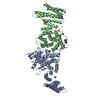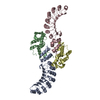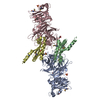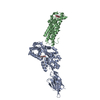+ Open data
Open data
- Basic information
Basic information
| Entry | Database: SASBDB / ID: SASDAA5 |
|---|---|
 Sample Sample | CHD4 (AH)
|
| Biological species |  Homo sapiens (human) Homo sapiens (human) |
 Citation Citation |  Journal: J Mol Biol / Year: 2012 Journal: J Mol Biol / Year: 2012Title: The PHD and chromo domains regulate the ATPase activity of the human chromatin remodeler CHD4. Authors: Aleksandra A Watson / Pravin Mahajan / Haydyn D T Mertens / Michael J Deery / Wenchao Zhang / Peter Pham / Xiuxia Du / Till Bartke / Wei Zhang / Christian Edlich / Georgina Berridge / Yun ...Authors: Aleksandra A Watson / Pravin Mahajan / Haydyn D T Mertens / Michael J Deery / Wenchao Zhang / Peter Pham / Xiuxia Du / Till Bartke / Wei Zhang / Christian Edlich / Georgina Berridge / Yun Chen / Nicola A Burgess-Brown / Tony Kouzarides / Nicola Wiechens / Tom Owen-Hughes / Dmitri I Svergun / Opher Gileadi / Ernest D Laue /  Abstract: The NuRD (nucleosome remodeling and deacetylase) complex serves as a crucial epigenetic regulator of cell differentiation, proliferation, and hematopoietic development by coupling the deacetylation ...The NuRD (nucleosome remodeling and deacetylase) complex serves as a crucial epigenetic regulator of cell differentiation, proliferation, and hematopoietic development by coupling the deacetylation and demethylation of histones, nucleosome mobilization, and the recruitment of transcription factors. The core nucleosome remodeling function of the mammalian NuRD complex is executed by the helicase-domain-containing ATPase CHD4 (Mi-2β) subunit, which also contains N-terminal plant homeodomain (PHD) and chromo domains. The mode of regulation of chromatin remodeling by CHD4 is not well understood, nor is the role of its PHD and chromo domains. Here, we use small-angle X-ray scattering, nucleosome binding ATPase and remodeling assays, limited proteolysis, cross-linking, and tandem mass spectrometry to propose a three-dimensional structural model describing the overall shape and domain interactions of CHD4 and discuss the relevance of these for regulating the remodeling of chromatin by the NuRD complex. |
 Contact author Contact author |
|
- Structure visualization
Structure visualization
| Structure viewer | Molecule:  Molmil Molmil Jmol/JSmol Jmol/JSmol |
|---|
- Downloads & links
Downloads & links
-Models
| Model #100 |  Type: dummy / Software: dammif / Radius of dummy atoms: 1.90 A / Chi-square value: 1.592644  Search similar-shape structures of this assembly by Omokage search (details) Search similar-shape structures of this assembly by Omokage search (details) |
|---|
- Sample
Sample
 Sample Sample | Name: CHD4 (AH) / Sample MW: 62.8 kDa / Specimen concentration: 1.40-8.60 |
|---|---|
| Buffer | Name: HEPES / Concentration: 50.00 mM / PK: 7 / pH: 7.5 / Comment: 4-(2-hydroxyethyl)-1-piperazineethanesulfonic acid / Composition: KCl 50.000 mM |
| Entity #84 | Name: CHD4 (AH) / Type: protein / Description: Human Chromatin Remodeler CHD4 (685-1233) / Formula weight: 62.8 / Num. of mol.: 1 / Source: Homo sapiens Sequence: MPGKKLKKVK LRKLERPPET PTVDPTVKYE RQPEYLDATG GTLHPYQMEG LNWLRFSWAQ GTDTILADEM GLGKTVQTAV FLYSLYKEGH SKGPFLVSAP LSTIINWERE FEMWAPDMYV VTYVGDKDSR AIIRENEFSF EDNAIRGGKK ASRMKKEASV KFHVLLTSYE ...Sequence: MPGKKLKKVK LRKLERPPET PTVDPTVKYE RQPEYLDATG GTLHPYQMEG LNWLRFSWAQ GTDTILADEM GLGKTVQTAV FLYSLYKEGH SKGPFLVSAP LSTIINWERE FEMWAPDMYV VTYVGDKDSR AIIRENEFSF EDNAIRGGKK ASRMKKEASV KFHVLLTSYE LITIDMAILG SIDWACLIVD EAHRLKNNQS KFFRVLNGYS LQHKLLLTGT PLQNNLEELF HLLNFLTPER FHNLEGFLEE FADIAKEDQI KKLHDMLGPH MLRRLKADVF KNMPSKTELI VRVELSPMQK KYYKYILTRN FEALNARGGG NQVSLLNVVM DLKKCCNHPY LFPVAAMEAP KMPNGMYDGS ALIRASGKLL LLQKMLKNLK EGGHRVLIFS QMTKMLDLLE DFLEHEGYKY ERIDGGITGN MRQEAIDRFN APGAQQFCFL LSTRAGGLGI NLATADTVII YDSDWNPHND IQAFSRAHRI GQNKKVMIYR FVTRASVEER ITQVAKKKMM LTHLVVRPGL GSKTGSMSKQ ELDDILKFGT EELFKDEATD |
-Experimental information
| Beam | Instrument name:  DORIS III X33 DORIS III X33  / City: Hamburg / 国: Germany / City: Hamburg / 国: Germany  / Shape: 0.6 / Type of source: X-ray synchrotron / Wavelength: 0.15 Å / Dist. spec. to detc.: 2.7 mm / Shape: 0.6 / Type of source: X-ray synchrotron / Wavelength: 0.15 Å / Dist. spec. to detc.: 2.7 mm | ||||||||||||||||||||||||
|---|---|---|---|---|---|---|---|---|---|---|---|---|---|---|---|---|---|---|---|---|---|---|---|---|---|
| Detector | Name: Pilatus 1M-W / Pixsize x: 0.172 mm | ||||||||||||||||||||||||
| Scan |
| ||||||||||||||||||||||||
| Distance distribution function P(R) |
| ||||||||||||||||||||||||
| Result | Comments: The ATPase CHD4 mediates nucleosome remodeling by the NuRD (nucleosome remodeling and deacetylase) complex. The NuRD complex serves as a crucial epigenetic regulator of cell ...Comments: The ATPase CHD4 mediates nucleosome remodeling by the NuRD (nucleosome remodeling and deacetylase) complex. The NuRD complex serves as a crucial epigenetic regulator of cell differentiation, proliferation, and hematopoietic development by coupling the deacetylation and demethylation of histones, nucleosome mobilization, and the recruitment of transcription factors. The three dimensional small-angle X-ray scattering model of CHD4 helps to define its interdomain interactions, with cross linking and limited proteolysis studies used to validate the model. Functional and binding assays suggest a regulatory role for the PHD and chromo domains.
|
 Movie
Movie Controller
Controller


 SASDAA5
SASDAA5










